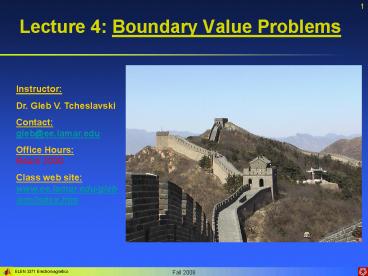Lecture 4: Boundary Value Problems - PowerPoint PPT Presentation
1 / 18
Title:
Lecture 4: Boundary Value Problems
Description:
Lecture 4: Boundary Value Problems Instructor: Dr. Gleb V. Tcheslavski Contact: gleb_at_ee.lamar.edu Office Hours: Room 2030 Class web site: www.ee.lamar.edu/gleb/em ... – PowerPoint PPT presentation
Number of Views:202
Avg rating:3.0/5.0
Title: Lecture 4: Boundary Value Problems
1
Lecture 4 Boundary Value Problems
Instructor Dr. Gleb V. Tcheslavski Contact
gleb_at_ee.lamar.edu Office Hours Room
2030 Class web site www.ee.lamar.edu/gleb/em/Inde
x.htm
2
What will we learn
So far, we considered fields in an infinite
space. In practice, however, we often encounter
situations when fields live in a finite space
consisting of bounded regions with different
electromagnetic properties. We have learned that
an electrostatic field could be created from a
charge distribution. The electric potential can
be obtained in terms of charge distributions via
Poissons equation. Now, we will examine how to
solve such equations in general.
3
Boundary conditions
We restrict our discussion to a 2D case and
Cartesian coordinates
With respect to the interface between two
boundaries, an EM field can be separated into a
parallel (tangential) and a perpendicular
(normal) components
4
Boundary conditions normal components
Normal components for the displacement flux
density D and the magnetic flux density B
Pillbox
Thickness
Cross-section area ?s
5
Boundary conditions normal components (cont)
We assume that there is a charge distributed
along both sides of the interface and has a total
charge density of ?s.
Electric field from the Gausss law
(4.5.1)
(4.5.2)
Magnetic field
(4.5.3)
(4.5.4)
6
Boundary conditions tangential components
Electric field the total work is
(4.6.1)
Assume that ?z portions can be neglected two
other edges
(4.6.2)
7
Boundary conditions tangential components (cont)
For the magnetic field, Amperes law
(4.7.1)
surface current density
Here, we again neglected integration over the top
and bottom edges.
(4.6.5)
8
Boundary conditions Example
The surface current with a density Js 20uy A/m
is flowing along the interface between two
homogeneous, linear, isotropic materials with ?r1
2 and ?r2 5. H1 15ux 10uy 25uz A/m.
Find H2.
1. Normal component
2. Tangential component
3. There is no change in the y-component of the
magnetic field. WHY?
9
Boundary with ideal conductor
Since the tangential electric field must be
continuous, and accounting for the Ohms law, it
must be a tangential current approaching
infinity! Therefore, the tangential current
density and tangential component of E must be
zero at the interface with a perfect
conductor. Ideal conductors are equipotential.
The consequence if we place a point charge above
an ideal conductor, it will create an electric
field that would be entirely in a radial
direction. Therefore, the tangential component of
E will be zero just beneath the charge. In order
to satisfy the zero tangential component
requirement at the other points of the surface,
we assume that so called image charge exists
inside the conductor.
10
Poissons and Laplaces equations
The Gausss law in differential form
(4.10.1)
Electrostatic field is conservative
(4.10.2)
Therefore, E is a gradient of electric potential
(4.10.3)
Combining (4.10.1) and (4.10.3), the Poissons
equation
(4.10.4)
If the charge density in the region is zero, the
Laplaces equation
(4.10.5)
11
Poissons and Laplaces equations
From non-existence of magnetic monopole
(4.11.1)
A vector magnetic potential such that
(4.11.2)
The Amperes law in differential form
(4.11.3)
Therefore
(4.11.4)
Via the vector identity, the Coulombs gauge is
(4.11.5)
Similarly to the Poissons equation
(4.11.6)
In the CCS
(4.11.7)
12
Poissons and Laplaces equations
Recall that the Laplacian operator in different
CSs
1. Cartesian
(4.12.1)
2. Polar
(4.12.2)
(4.12.3)
3. Spherical
13
Poissons equation Example
Show that the 2D potential distribution Satisfies
the Poissons equation
Let us evaluate the Laplacian operator in the
Cartesian CS
Therefore
At this point, we derived the Poissons and
Laplaces equations in 3D. Next, we will attempt
to solve them to find a potential.
14
Analytical solution in 1D Direct integration
Calculate the potential variation between two
infinite parallel metal plates in a vacuum.
We assume no resistance, therefore, no variation
in y and z directions.
(4.14.1)
Since no charges exist between plates, we need to
solve the Laplaces equation
(4.14.2)
Boundary conditions V V0 at x 0 V 0 at x
x0
(4.14.3)
15
Analytical solution in 1D Direct integration
The solution of the Laplaces equation will be in
the form
(4.15.1)
Here C1 and C2 are integration constant that can
be found from boundary cond.
(4.15.2)
Finally, the solution
(4.15.3)
The electric field is
(4.15.4)
16
Analytical solution in 1D Direct integration
Lets assume that there is a charge with ?v
uniformly distributed between plates
Poissons equation
(4.16.1)
The solution will be in form
(4.16.2)
from the boundary conditions
(4.16.3)
Finally
(4.16.4)
(4.16.5)
17
Analytical solution in 1D Direct integration
18
Conclusions
Steps for solving either Poissons or Laplaces
equation analytically
- Chose the most appropriate representation of
Laplacian based on any symmetry. - Perform the integration of the differential
equation to obtain the most general solution for
the potential. - Let this general solution to satisfy the boundary
conditions to find constants of integration.
Additionally, numerical methods, such as Finite
Difference Method, Finite Element Method, Method
of Moments, are developed to solve Boundary Value
problems in situations where analytical solution
is hard to find.































